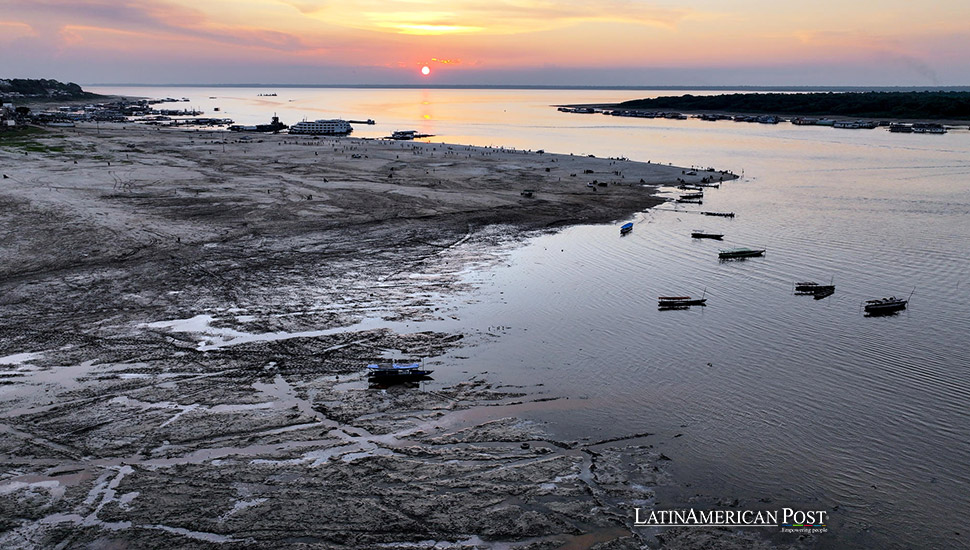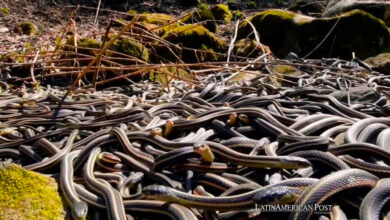Warming Waters Threaten Brazilian Amazon Lakes and River Dolphins

A new study reveals that water temperatures in several Amazon lakes have surpassed last year’s record highs, endangering species such as the gray and pink river dolphins. The ongoing drought worsens the outlook for biodiversity and local ecosystems.
Record-High Temperatures Devastate Amazonian Lakes
The heart of the Brazilian Amazon, home to some of the world’s most diverse aquatic ecosystems, is facing an unprecedented environmental crisis. According to a recent study conducted by WWF-Brazil and MapBiomas, temperatures in 12 lakes have already surpassed the 40-degree Celsius record set in 2023. This alarming rise is part of a broader warming trend affecting lakes throughout the region, which threatens to worsen in the coming months as the Amazon endures its harshest drought in years.
The data highlights a disturbing reality: the delicate balance of these ecosystems is being severely disrupted by rising water temperatures. Last year, this phenomenon claimed the lives of over 330 Amazonian dolphins in the Tefé and Coarí lakes, two of the most affected bodies of water. Researchers warn that this year could be even more devastating, as temperatures in 12 monitored lakes, including Lago Calado, exceeded last year’s maximums by as much as 0.86 degrees Celsius by late September.
The warming of these lakes is not only a sign of climate change but also a direct consequence of the region’s ongoing drought. Water levels in the Amazon’s major rivers, including the Solimões and Negro, have reached record lows, exacerbating the already dangerous conditions in the lakes they feed. As a result, shallow waters that cannot cool down sufficiently during the dry season are overheating alarmingly. The consequences for aquatic life are dire, and the ripple effects could extend to the broader ecosystem and local communities that depend on fishing for their livelihood.
Dolphins Face New Threats
The Amazon’s pink and gray river dolphins, iconic species known for their adaptability to the complex river systems of the Amazon basin, are now facing a new and deadly challenge. The high water temperatures recorded in the Tefé and Coarí lakes last year, where hundreds of dolphins perished, are now being replicated and even surpassed in lakes throughout the region. With temperatures rising above 40 degrees Celsius, these aquatic mammals struggle to survive in the increasingly hostile environment.
Dolphins are particularly vulnerable to extreme heat, as their bodies are adapted to calmer waters. When temperatures exceed their tolerance limits, their ability to regulate body temperature diminishes, leading to heat stress, weakened immune systems, and, eventually, death. The death of hundreds of dolphins in 2023 serves as a warning of what could happen this year if conditions continue to worsen.
The study’s findings also point to the interconnected nature of the Amazon’s aquatic life. Not only are dolphins at risk, but other species that rely on the same waters face the consequences of this extreme heat. Rising water temperatures also affect fish populations, a critical food source for dolphins and local communities. As their habitats heat up, fish are forced to either migrate to more excellent areas or face population decline due to unfavorable breeding conditions.
These environmental changes threaten the way of life of indigenous and local fishing communities. The reduction in fish stocks impacts food security, and the loss of biodiversity could have long-term effects on the region’s ecological balance. The traditional knowledge and practices of these communities are deeply tied to the natural rhythms of the rivers and lakes, which are now being upended by the climate crisis.
Satellite Monitoring and Data Analysis Reveal Crisis
Cutting-edge satellite monitoring technology has revealed the scale of the warming crisis in the Amazon’s lakes. WWF-Brazil and MapBiomas, collaborating with the Mamirauá Institute and the Chico Mendes Institute for Conservation and Biodiversity (ICMBio), have developed a platform that uses remote sensing data to track temperature changes in the region’s lakes. This technology allows scientists to monitor water temperature variations over time, providing real-time insights into how conditions evolve.
According to Ayan Fleischmann, coordinator of the Mamirauá Institute’s Geosciences Group, satellite data has filled a crucial gap in monitoring the Amazon’s lakes. The remote sensors detect temperature anomalies on the water’s surface, triggering alerts when the readings indicate potentially dangerous conditions. This system is precious in a region as vast and inaccessible as the Amazon, where traditional monitoring methods are often limited.
The study has focused on 23 lakes connected to major rivers like the Madeira, Negro, Parú, Purus, Solimões, Tapajós, and Trombetas. These lakes share a similar geomorphology, characterized by elongated shapes and shallow depths, which makes them highly susceptible to overheating. As the dry season progresses, these lakes already experiencing elevated temperatures are likely to see even more dramatic increases.
In some cases, the temperature differences may seem small—Lago Calado, for example, has recorded an increase of 0.86 degrees Celsius compared to 2023—but even these slight changes can have significant ecological impacts. These changes can be life-threatening for species adapted to stable temperature ranges, such as the Amazon’s dolphins.
The findings from the satellite monitoring program have provided valuable data that can help shape future conservation strategies. However, the researchers involved in the study warn that time is running out. With the dry season expected to last at least two more months, the likelihood of further temperature increases remains high, raising concerns about the potential for a repeat of last year’s dolphin die-off and possibly worse.
The Urgent Need for Action as Amazon Drought Deepens
The ongoing drought in the Amazon is not only an environmental crisis but also a social and economic one. As water levels in the region’s significant rivers continue to drop, the impacts on local communities, biodiversity, and the economy become more severe. The Amazon River, a lifeline for the region, is experiencing unprecedented low levels, affecting everything from transportation and agriculture to fishing and water supply.
In addition to the immediate threats posed by the drought and rising water temperatures, the long-term implications of these changes are becoming increasingly apparent. As the Amazon’s hydrological cycle is disrupted, the region’s ability to support its rich biodiversity is compromised. This has led to calls for urgent action to address the root causes of the crisis, including climate change, deforestation, and poor water management practices.
Juliano Schirmbeck, technical coordinator of MapBiomas Agua, emphasizes that the situation could worsen in the coming months. “We still have two more months of drought ahead of us, and these numbers indicate that by September and October, during the peak of the dry season, we will see temperatures far exceeding last year’s records,” he says. This warning underscores the need for immediate measures to mitigate the damage and protect the ecosystem and its inhabitants.
One proposed solution is the development of early warning systems that can detect temperature anomalies in real time and provide alerts to local authorities and conservation organizations. Such systems would allow quicker responses to environmental changes, potentially saving lives and minimizing damage. Additionally, there is a growing push for more sustainable water management practices that can help alleviate the strain on the region’s lakes and rivers during periods of drought.
Also read: Brazil Leads the Way: Pioneering Data Privacy in Meta’s AI Revolution
Addressing the Amazon’s environmental crisis will require concerted efforts from governments, NGOs, and the international community on a broader scale. Reducing deforestation, curbing greenhouse gas emissions, and promoting conservation initiatives are all critical steps in preserving the Amazon’s ecosystems. The stakes have never been higher for the people and wildlife that call this region home





